Quick Facts About Veterinarians
- How many veterinarians are there in the United States? There were approximately 109,470 veterinarians actively employed in the US, in 2021. [14]
- How many veterinary clinics are in the US? There are roughly 30,000 veterinary practices in the US. These largely cater to companion animals (primarily cats and dogs). Out of these, about 17% of clinics are corporate-owned. [15]
- Is there a high demand for veterinarians? Yes, there is a very high demand for veterinarians. In fact, job growth for vets is expected to grow 19% for the next decade (much faster than the average for most jobs). Roughly 4,800 openings for veterinarians are projected each year, on average. [10]
- How big is the veterinary industry? The veterinary industry is large and is only expected to grow. In 2021, the U.S. veterinarian market size was valued at $11.03 billion and is expected to grow at an annual rate of 8.7% from 2022 to 2030.[16]
Veterinarian Demographic Statistics
What’s the demographic profile of the average veterinarian in the United States?
1. Over 60% of veterinarians in the US are women
This is a significant increase compared to a decade ago. In 2010, only 50.12% of practicing veterinarians were women. 2015 marked the largest shift, going from 55% women and 45% men to 59% and 41% men in 2016.[1]
2. The average age of veterinarians is 40+ years old, which represents 57% of the vet population.
Younger veterinarians are less common, with 36% of vets being 30-40 years old, and just 8% being 20-30 years old.[1] Of course, considering the additional education veterinarians must obtain, it is not surprising that there are fewer under 40 years old.
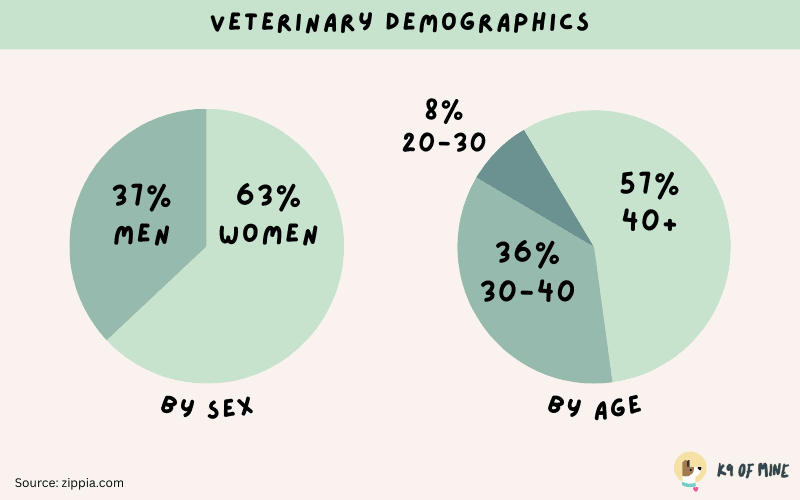
3. 83% of veterinarians are white, 6% are of Hispanic or Latino ethnicity, and 4.8% are Asian.
Today, white veterinarians make up the largest demographic (83%), followed next by Hispanic or Latino ethnicity (6%), Asian ethnicity (5%), unknown ethnicity (4%), black or African American ethnicity (1.4%), and less than 1% Native American or Indigenous people. [1]
While the profession still has a long way to go in terms of diversity, inroads are being made. In 2012, 90% of veterinarians were white. Only 4.5% were Hispanic or Latino, and just 3.5% were Asian.
The good news is that this may change soon — the AAVMC reports that nearly 10% of veterinary students in 2022 were of Hispanic or Latino ethnicity.[2]
The College of Veterinary Medicine at Tuskegee University boasts the highest number of students (70%) who are of races and ethnicities that are under-represented in veterinary medicine.[2]
4. 15% of all veterinarians are LGBT.
In recent reporting, 15% of veterinarians identified as LGBT.[1]
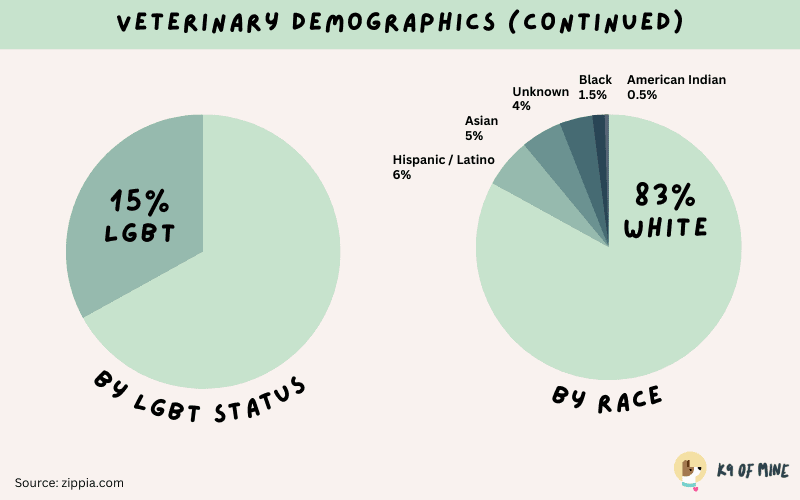
Vet Salaries: How Much Do Veterinarians Make?
1. $108,443 is the average annual pay for a Veterinarian in the United States in 2023.
An average annual pay of $108,443 works out to be about $52.14 an hour. This is the equivalent of $2,085/week or $9,036/month.[3]
Breaking this down another way, veterinarians in the US have to work an average of 18.7 hours to afford rent for housing.
2. Veterinary surgery specialists make the most money with an average salary of $266,908 per year.
Board-certified veterinary surgery specialists make the most money out of all veterinary positions, with an average salary of $266,908 per year.[5]
Zoo veterinarians make the least, with an average salary of $59,986 per year.
The average pay range for a veterinarian can vary as much as $36,500, suggesting that pay can change substantially depending on one’s skill level, location and years of experience.
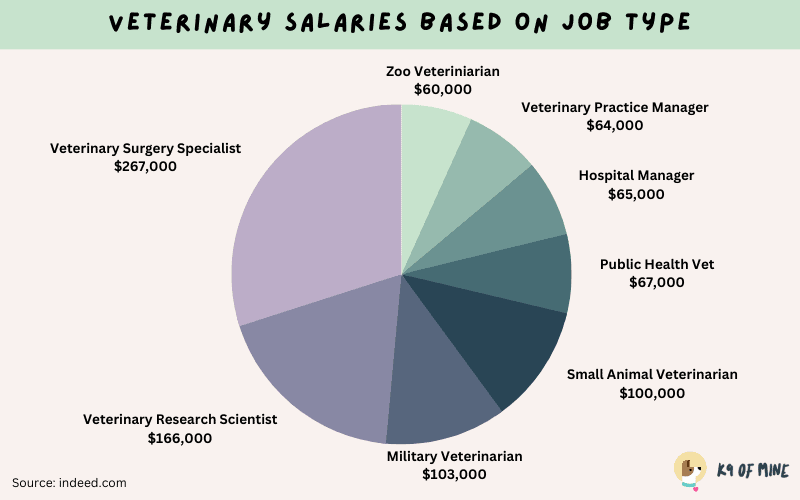
3. In 2021, women earned 87% of what men earned.
There are obvious gender pay gap issues in veterinary medicine. Women earn 87¢ for every $1 earned by men, with the average male’s salary as a veterinarian averaging in at $122,597, compared to women veterinarians making an average of $106,803. [1]
Where Do Vets Make the Most Money?
1. Veterinarians reportedly make the most money in San Mateo, CA.
Other top cities close behind San Mateo, CA where veterinarians can make the most money include Boston, MA and Green River, WY.
Vets in San Mateo, CA make 17.5% above the average vet salary, while Green River, WY vets make 16% more.[3]
The lowest-paying states for veterinarians are spread throughout the US, but are primarily found in western and midwestern states, such as Washington, Colorado, Minnesota, Oklahoma, and Nebraska.[9]
Veterinary Schooling Statistics
1. There are 32 schools or colleges of veterinary medicine (CVMs) in the U.S
There are 32 schools or colleges of veterinary medicine (CVMs) in the U.S. that are accredited or have accreditation pending – all of them are AAVMC (American Association of Veterinary Medical Colleges) members. [12]
2. About 3,200 veterinary students graduate each year from colleges of veterinary medicine in the U.S.
The number of veterinary graduates can be seen as an indicator of the demand for veterinary services in the U.S. With 3,200 new graduates each year, there is a steady influx of professionals joining the field to meet the demands of animal care.[12]
On average, the number of veterinary students has increased 2.0% per year since 1980. During the last decade (2011-2022), the number of first-year students at US colleges of veterinary medicine has increased an average of 2.6% per year.[2]
The Ohio State University College of Veterinary Medicine is the veterinary school with the highest number of enrolled veterinary students, followed by the Iowa State University College of Veterinary Medicine and the Texas A&M School of Veterinary Medicine.[2]
3. Texas had the most first-year students enrolled at veterinary schools in 2022.
Roughly 350 first-year AAVMC students in 2022 were from Texas, followed closely by California.
This isn’t a huge surprise, as these are two of the states with the highest number of veterinary jobs.
Florida had the next closest amount of veterinary students, with roughly 250 students. Oregon had the least amount of veterinary students, with roughly 50.[2]
4. Median annual tuition for veterinary school is about $53,000 for out-of-state students and $32,000 for in-state students.
The Long Island University College of Veterinary Medicine is one of the most expensive for in-state students at 60k per year. The least expensive for in-state residents is NC State University’s College of Veterinary Medicine at roughly 20k per year.[2]
The Ohio State University College of Veterinary Medicine and the University of Arizona’s College of Veterinary Medicine are the most expensive options for non-residents, at approximately 70k tuition.
The Michigan State University College of Veterinary Medicine is the best option for non-residents, at under 50k tuition.
5. Vet students usually graduate with over 150k in debt.
The mean indebtedness in 2019 of veterinary medical students who have debt is $176,920. 20% of veterinarian students graduate with no debt.[12]
6. Vet schools are now 80% to 90% women.
This mirrors the increasingly high number of women practicing in the veterinary field. In 2010, women made up just roughly 70% of the veterinary student body.[2]
7. Rural students may be able to get into veterinary school for less money.
Several states have early commitment programs for rural students in animal science programs, due to the desperate need for more veterinarians in rural areas, where many peoples’ living depends on the health of their livestock animals.
The federal Veterinary Medicine Loan Repayment Program (VMLP) pays up to $25,000 each year toward student loans of eligible veterinarians who agree to serve in a designated shortage area for three years.[11]
Only about 10% of final-year students at veterinary schools have an interest in food animal medicine at graduation.
8. Over 25% of vet school applicants in 2022 identified as first-generation college students.
Over a quarter of 2022 vet school applicants for the class of 2026 identified as first-generation college students. Over a quarter of the applicants were also eligible for Federal Pell Grants.[2]
9. Nearly 20% of veterinary school applicants had to apply more than once in 2022.
While roughly 75% of veterinary students only had to apply once to gain entrance to veterinary medical school, 20% had to apply a second time. Roughly 5% had to apply a third or fourth time.[2]
10. University of Pennsylvania’s Veterinary School has the highest graduation rate (96%)
Among the best Veterinary Medicine schools, the University of Pennsylvania has the highest graduation rate of 96%. Clocking in with the lowest graduation rate is Colorado State University-Fort Collins with 69%. [13]
Veterinary Industry Statistics: Vet Career Info
1. There are approximately 86,300 veterinarians employed in the United States
There are roughly 86,300 veterinarians employed in the US, [10] and approximately 30,000 veterinary practices in the US. These largely cater to companion animals (primarily cats and dogs). Out of these, about 17% of clinics are corporate-owned. [15]
2. Which cities have the most veterinarians in the US?
New York, NY has the most veterinarians, with over 3,000 employed veterinarians. The next city with the second-most veterinarians is Los Angeles, CA with 2,100, followed by Chicago, IL with 1,860.[14]
Washington, DC employs the fewest vets, only about 90.
3. Austin, TX is one of the easiest places to get a job as a vet.
Veterinarians are in high demand in Austin, TX. In 2021, there were roughly 57 job openings for veterinarians in Austin, TX. [1]
4. California is the state employing the most veterinarians.
California employs 7,380 vets, which is the most in the country—that’s almost 65% more as many veterinarians as Texas, which has the second-most vets.[9]
California is the U.S. state with the most vets, with 1,017 vet jobs.[1]
This is likely due to the state’s large size as well as the multitude of individuals there who have pets as companion animals as well as the many farmers who rely on their livestock for a living.
Source: Zippia.com 
5. Job security is great as a veterinarian, with a .37% unemployment rate.
Veterinarians tend to have very low unemployment rates, with just .37% of vets being unemployed in 2021 (down from .88% in 2010) [1]
6. Roughly 3% of all veterinarians in the US are employed by the government.
It’s estimated that 3% of all veterinarians in the US are employed by the US government.[10] Of the 3,200 federally-employed veterinarians, over 50% work at the United States Department of Agriculture.[6]
Federal veterinarians have gone into space with NASA, perform surgery on elephants at the National Zoo, and are elected to the U.S. Congress.
7. Smaller owner-run private practices are less common today than they once were.
Of the approximately 30,000 veterinary practices in the U.S. today, about 3,500 are corporate-owned.[11] This is due in part to the increased interest in consolidation from corporate companies as well as the huge increase in private equity firms buying up veterinary practices during the pandemic.
8. Job growth in the field of veterinary medicine is expected to be 19%
Employment of veterinarians is projected to grow 19% from 2021 to 2031, much faster than the average for all occupations. [10] About 4,800 openings for veterinarians are projected each year, on average, over the decade.
Veterinary Practice Statistics: What Animals to Veterinarians Work With?
1. 77% of veterinarians who work in private medical practices treat pets.
It’s estimated that 77% of veterinarians who work in private medical practices treat pets. [8]
And in fact, over 50% of private practice veterinarians predominantly, or exclusively treat small animals, such as dogs and cats, as well as birds, reptiles, and rabbits.
25% of all veterinarians work in mixed animal practices, where they see pigs, goats, sheep, and some non-domestic animals in addition to companion animals.
16% of veterinarians work in private mixed and food animal practices, where they see pigs, goats, cattle, sheep, and some wild animals in addition to farm animals. 6% of private practice veterinarians work exclusively with horses.
Statistics About Veterinarian Job Satisfaction
1. Nearly one-third of veterinary staff say they are “very likely” to leave their practice in the next two years.
Veterinarians struggle with workplace satisfaction, with 31% of vet staff saying they were “very likely” to leave their practice in the next two years. 22% said they’d stay less than one year.[1]
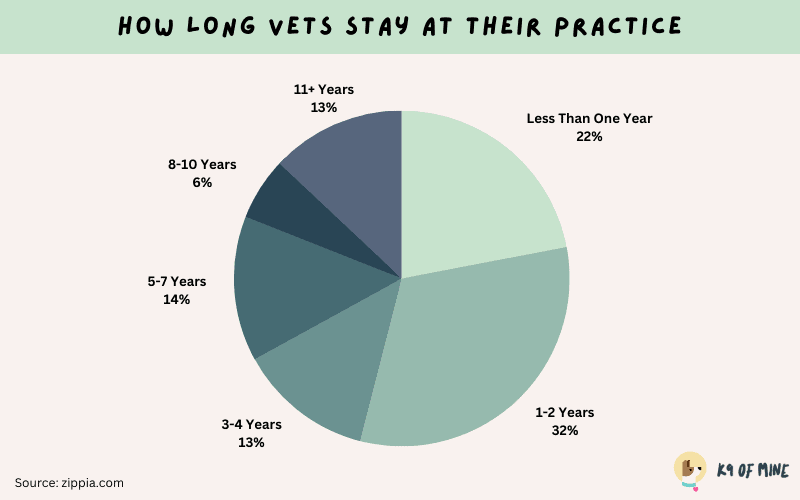
2. Less than 50% of veterinarians would recommend veterinary medicine as a career, and nearly 1 in 5 regret becoming a veterinarian.
Not only do less than 50% of veterinarians recommend veterinary medicine as a career, but nearly 1 in 5 vet regret becoming a veterinarian.[4]
Burnout remains a serious issue among both veterinarians and staff, and this shows in many vets reluctance to recommend the profession. A significant amount regret becoming a veterinarian at all. Vets cite the shortage of staff, work overload, and student debt as primary sources of stress.
3. The pandemic has been especially hard on veterinarians.
Percentage of practicing veterinarians “suffering” has increased from 9.4% to 12.3% since 2019. [4]
4. Veterinarians are at an increased risk for suicide.
Veterinarians in the U.S. are at an increased risk of suicide, according to a study by the Center for Disease Control. [7]
Firearms is the most commonly used method of suicide for veterinarians, but 37% of suicides among veterinarians were caused by pharmaceutical poisoning. This is 2.5 times higher than pharmaceutical poisoning among the general U.S. population, and is likely due to the fact that veterinarians have easy access to euthanasia drugs, along with the understanding of what would constitute a lethal dose.[7]
Veterinarians have been shown to be higher in neuroticism and lower in extraversion than non-veterinarians – with both being proven predictors of wellbeing and mental health.
59% of veterinarians with serious psychological distress reported that knew they needed help within the past year but didn’t or couldn’t get it. [4]
5. Female veterinarians are 3.5 times more likely to die of suicide.
Female veterinarians are 3.5 times more likely to die of suicide, and male veterinarians were 2.1 times as likely, to die from suicide, compared to the general population. [7]
Since 2000, the proportion of female veterinarians who died by suicide has remained stable at 10%. However, the overall number of deaths has increased steadily.
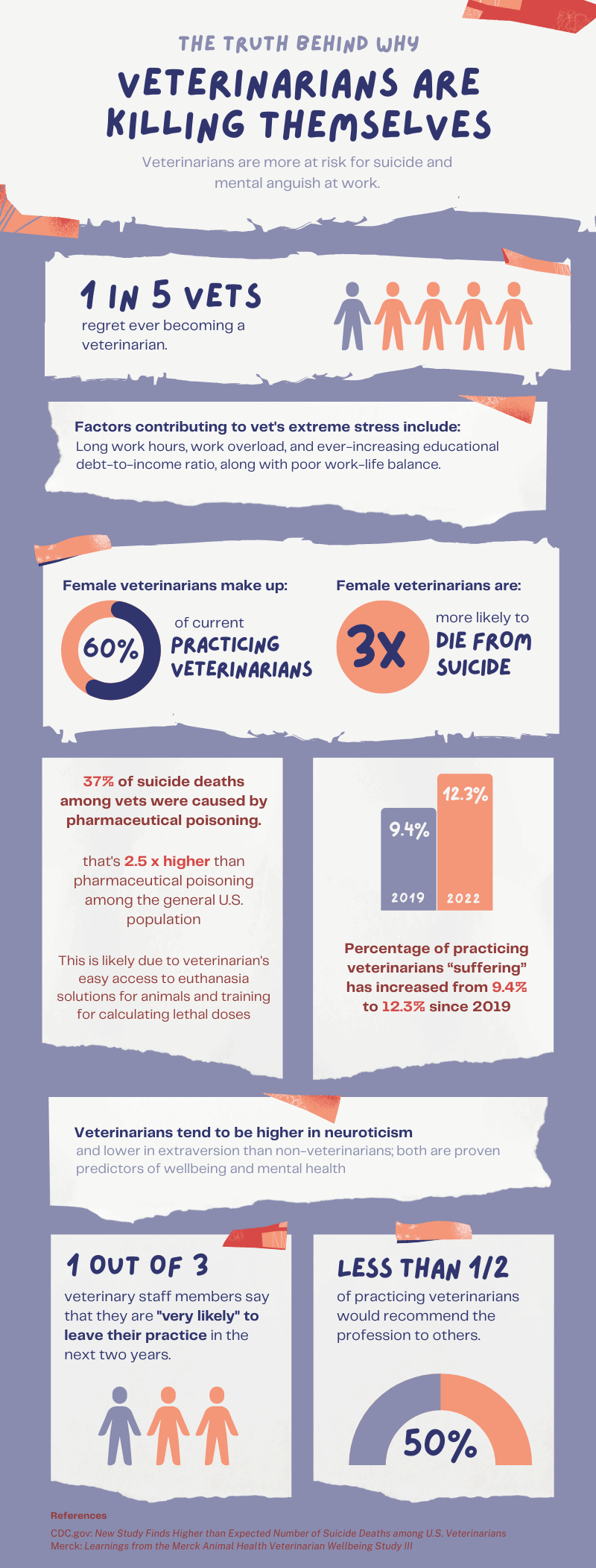
FAQs Regarding Veterinarians
How many hours a week does a vet work?
Most veterinarians work full-time, and will often work more than 40 hours per week. Some veterinarians work nights or weekends, and may also have to respond to emergencies, even outside of scheduled work hours.
According to one study[9], veterinarians in the US have to work an average of 18.7 hours to afford rent for housing (much less than many other jobs).
What are the highest-paid vet specialties?
Board-certified veterinary surgery specialists make the most money out of all veterinary positions, with an average salary of $266,908 per year. The next highest-paid vets are professors of veterinary medicine, making an average salary of $166,350 per year. The third highest-paying vet specialty is a veterinary research scientist ($111,691), followed by a military veterinarian ($103,090). [5]
What percentage of veterinarians are female?
60% of working veterinarians are female. That number increases even more for veterinarians currently in school — vet schools are now 80% to 90% women.[2]
How much do vets make yearly?
Vets make an average of $108,443 yearly, although the exact salary can vary quite a bit depending on one’s specialty and the location of one’s practice.[3]
How much do veterinarians make a day?
Veterinarians make an average of $417 per day. [3]
How much do vets make a week?
When diving the average vet’s annual salary, it works out to be the equivalent of $2,085 per week or $9,036 each month for a vet’s payment.[3]
What are the projections for the veterinary industry?
The veterinary industry is expected to grow rapidly within the coming years. Job growth for the veterinary industry is expected to grow 19% for the next 10 years (which is considerably faster than most jobs).[10]
What are the top three industries that employ veterinarians?
The industry of professional and scientific services employs the most (93%) veterinarians — this is largely composed of private practice veterinary clinics serving companion animals as well as farm animals). The federal government employs the next largest number of veterinarians, employing 6% of all vets.[10]
Sources:
- https://www.zippia.com/veterinarian-jobs/demographics/
- Annual Data Report 2021-2022 [Internet]. Washington, DC: American Association of Veterinary Medical Colleges; 2022 April. P. 1-67. Available form: https://www.aavmc.org/about-aavmc/public-data
- https://www.ziprecruiter.com/Salaries/Veterinarian-Salary
- Learnings from the Merck Animal Health Veterinarian Wellbeing Study III. 2022 January. https://www.merck-animal-health-usa.com/
- https://www.indeed.com/career-advice/finding-a-job/highest-paid-veterinarians
- https://www.fda.gov/animal-veterinary/animal-health-literacy/federal-veterinarians-work
- CDC.gov Centers for Disease Control and Prevention
- https://www.careercornerstone.org/veterinarian/veterinarian.htm
- https://www.business.org/hr/workforce-management/best-us-states-for-veterinarians/
- Bureau of Labor Statistics, U.S. Department of Labor, Occupational Outlook Handbook, Veterinarians, at https://www.bls.gov/ooh/healthcare/veterinarians.htm
- https://www.agriculture.com/livestock/call-the-vet-rural-veterinary-medicine-is-struggling
- https://www.aavmc.org/about-aavmc/faqs/#media
- https://www.univstats.com/comparison/veterinary-medicine/graduation-rate/
- U.S. Bureau of Labor Statistics, BLS Data Finder
- https://www.columbusceo.com/story/business/briefs/2021/02/02/vet-practice-fever-burns-as-clinics-change-hands/43370487/
- https://www.grandviewresearch.com/industry-analysis/us-veterinarians-market








Leave a Comment